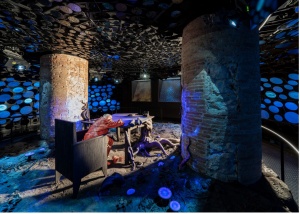Antoni Gaudí and Casa Batlló: Barcelona’s Dynamic Duo Set to Woo the Crowds

Barcelona, the charismatic capital of Catalonia, is known for its dynamic energy, sun-kissed beaches, vibrant culture, and awe-inspiring architecture. Yet, even in this thriving metropolis, the iconic works of Spanish architect Antoni Gaudí stand out as masterpieces of creativity and innovation.
Following the Casa Batlló‘s 2022 best international exhibit award, visitors to Barcelona are eager to explore the cityscape, and Gaudí‘s distinctive style, which has indelibly imprinted on Barcelona’s soul, As such, the focus for many visitors are focusing on Antoni Gaudí genius and influences behind three of his most celebrated creations - the Sagrada Familia, Casa Batlló, and La Pedrera. Antoni Gaudí the Great Modernist Influencer.
Born in 1852, either in Reus or Riudoms, Catalonia, Antoni Gaudí was a visionary who blazed a unique trail in the architectural world. He attended the Barcelona School of Architecture, where his imaginative designs sparked intrigue and controversy. Gaudí drew inspiration from the organic forms of nature, integrating them into his architecture in innovative ways. His eclectic style and willingness to defy convention ushered in a new era of Modernist architecture.
Sagrada Familia
Among Gaudí‘s remarkable repertoire, the Sagrada Familia is undeniably the crown jewel. This stunning basilica is the embodiment of Gaudí‘s vision - a perfect union of nature and architecture. From its forest-like columns to its towering spires, the Sagrada Familia is a monument to Gaudí‘s genius. Despite its unfinished state, it is a symbol of the city and the determination of a man who dedicated his final 15 years to this project.
Today, over a century since its inception, the Sagrada Familia remains a source of fascination and inspiration to architects and enthusiasts worldwide.
Casa Batlló
Yet, the genius of Gaudí is not limited to the monumental Sagrada Familia. Situated in the bustling Passeig de Gracia, Casa Batlló is another testament to Gaudí‘s remarkable vision. What was once a nondescript building was transformed by Gaudí into an artistic marvel that blends seamlessly with its urban surroundings. The façade, reminiscent of calm, tranquil sea waves, is made of iridescent glass and ceramic fragments. The interior is equally captivating, with its flowing lines and marine-themed motifs creating an otherworldly environment.
Casa Batlló, a UNESCO World Heritage site, provides a fascinating glimpse into Gaudí‘s fertile imagination and is a must-visit landmark in Barcelona.
La Pedrera
Further along Passeig de Gracia lies La Pedrera, another iconic creation from Gaudí‘s architectural palette. Known officially as Casa Milà, this residential building boasts an undulating façade that challenges conventional design norms. The rooftop, adorned with chimneys styled as warrior helmets, offers a commanding view of the city. La Pedrera showcases Gaudí‘s innovative use of space and light in a manner that was revolutionary for its time and remains impressive to this day.
Gaudí‘s architecture is not just about creating structures; it’s about crafting narratives in stone, ceramics, and glass. Every building he designed is a testament to his ability to transcend architectural norms. He didn’t just construct buildings; he sculpted masterpieces that continue to captivate audiences with their perfect blend of aesthetics and functionality.
Antoni Gaudí and Modernism
Antoni Gaudí‘s name is practically synonymous with Barcelona’s modernism movement, which thrived from the late 19th to the early 20th century. Gaudí, often heralded as the father of this artistic and cultural renaissance, employed groundbreaking techniques that melded organic forms with architectural structures, creating an innovative style that was distinctly his own.
His genius lay not just in the uniqueness of his vision, but also in his ability to realize this vision through the use of materials such as iron, ceramics, stained glass, and natural stones. This integration of diverse elements and unconventional designs ushered in a new era of architecture and secured Gaudí‘s place in the annals of modernism.
Gaudí‘s influence on modernism wasn’t confined to the architectural domain alone; it extended to other aspects of Catalan culture and arts, shaping them in profound ways. His innovative use of space, light, and color transcended the confines of structural design, inspiring artists, sculptors, and designers alike. Gaudí, as a representative of modernism, challenged the normative aesthetics of his time, promoting the idea that beauty and functionality could coexist harmoniously.
His works, marked by a symbiotic relationship with nature and a keen understanding of geometric forms, established him as a vanguard of the modernist movement, redefining the boundaries of art and architecture.
Even today, Gaudí‘s modernist creations continue to inspire and influence artists, designers, and architects worldwide, ensuring his enduring legacy in the realm of modernist art and culture.
Today, the Sagrada Familia, Casa Batlló, and La Pedrera stand not just as historical landmarks but as vibrant storytellers of Gaudí‘s creative genius. They offer visitors a window into the mind of an architect whose innovative designs were far ahead of his time. Each visit to these sites is a voyage into Gaudí‘s imagination, as we marvel at his ability to transform natural forms into architectural marvels.
As such, these three significant Gaudí works are expecting high visitor numbers this year.

